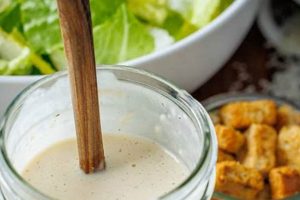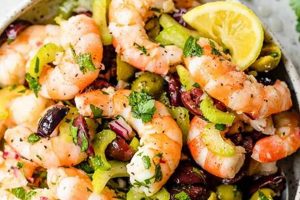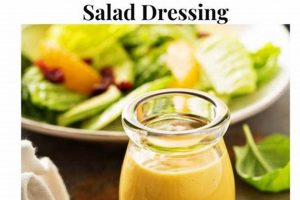A basic vinaigrette, often composed of oil, vinegar, and seasonings, exemplifies an easy-to-prepare condiment for leafy greens and other vegetables. Variations may include additions such as Dijon mustard, honey, maple syrup, or fresh herbs to create a wider range of flavor profiles.
Effortless preparation and adaptability make such condiments valuable additions to any culinary repertoire. From a nutritional standpoint, homemade versions allow control over ingredients, potentially reducing added sugars and unhealthy fats often found in commercially produced dressings. Historically, basic mixtures of oil and acidic liquids have served as flavor enhancements for centuries, evolving into the diverse range of dressings enjoyed today. The ability to customize these fundamental recipes empowers individuals to create dressings perfectly suited to individual palates and dietary needs.
This exploration will delve further into specific formulas for creating delicious, uncomplicated dressings suitable for everyday meals and special occasions. Topics will include suggested ingredient ratios, techniques for emulsification, storage recommendations, and innovative flavor combinations.
Tips for Creating Delicious Salad Dressings
Creating flavorful salad dressings at home is easier than one might think. These tips offer guidance for achieving delicious results with minimal effort.
Tip 1: Start with quality ingredients. The foundation of any good dressing lies in the quality of its components. Select extra virgin olive oil for its robust flavor and health benefits. Freshly squeezed lemon or lime juice provides brighter acidity than bottled varieties.
Tip 2: Balance flavors. A harmonious blend of sweet, sour, salty, and savory elements is key. Achieve this balance through judicious use of acids (vinegar, citrus juice), sweeteners (honey, maple syrup), and seasonings (salt, pepper, herbs, spices).
Tip 3: Emulsify effectively. A stable emulsion prevents the dressing from separating. Whisk ingredients vigorously or use a blender to combine the oil and aqueous components thoroughly.
Tip 4: Taste and adjust. Palates vary, so tasting and adjusting seasonings is crucial. Add ingredients incrementally, reassessing the balance after each addition.
Tip 5: Experiment with flavors. Don’t be afraid to explore different flavor combinations. Incorporate fresh herbs, spices, garlic, ginger, or other aromatics to create unique and exciting dressings.
Tip 6: Store properly. Homemade dressings can be stored in airtight containers in the refrigerator for up to a week. Shake well before serving, as some separation may occur.
Tip 7: Consider the salad. Pair dressings with salads thoughtfully. Lighter dressings complement delicate greens, while bolder flavors enhance heartier salads.
By following these tips, one can elevate simple salads with homemade dressings tailored to individual preferences. Fresh, flavorful, and customized dressings contribute significantly to a more enjoyable and healthful dining experience.
The subsequent section will offer specific recipe examples demonstrating these principles in practice, providing tangible illustrations of how to create a variety of delicious salad dressings.
1. Fresh Ingredients
Superior quality in a simple salad dressing hinges directly on the freshness of its components. Use of fresh ingredients elevates flavor profiles, offering noticeable improvements over pre-packaged or stale alternatives. This section explores the impact of fresh components on overall quality.
- High-Quality Oils
Oils constitute a significant portion of most dressings. Extra virgin olive oil, known for its robust flavor and health benefits, offers a superior foundation. Other oils like avocado or grapeseed oil provide alternative flavor profiles and health properties. Fresh, high-quality oils contribute significantly to a dressings overall taste and texture.
- Freshly Squeezed Citrus
Citrus juice provides necessary acidity. Freshly squeezed lemon or lime juice offers a brighter, more vibrant flavor compared to bottled counterparts. This fresh acidity enhances the other ingredients and balances the richness of the oil.
- Herbs and Spices
Fresh herbs and spices contribute significantly to the complexity and depth of flavor. Dried herbs can be used, but fresh herbs offer a more pronounced, nuanced taste. Incorporating fresh herbs like dill, mint, or parsley elevates a basic vinaigrette to a new level of culinary sophistication.
- Seasonal Produce
Expanding beyond the core components, incorporating fresh, seasonal produce adds another dimension to a simple dressing. Ingredients like ripe tomatoes, avocados, or berries can be blended into dressings, offering unique flavors and enhancing nutritional value.
Utilizing fresh, high-quality ingredients in simple salad dressings significantly enhances the final product. The vibrancy and complexity of flavors achieved through fresh components contribute to a more enjoyable and satisfying culinary experience. Prioritizing fresh ingredients transforms a basic dressing into a flavorful complement that elevates any salad.
2. Balanced Flavors
Balance constitutes a cornerstone of palatable salad dressings. A successful, simple recipe hinges on the harmonious interplay of four fundamental tastes: sweetness, sourness, saltiness, and bitterness. The careful calibration of these elements ensures a dressing complements, rather than overwhelms, the flavors of the salad itself. A dressing excessively acidic can be jarring, while one lacking acidity can taste bland. Similarly, an overabundance of sweetness cloys, and insufficient saltiness renders the other flavors muted. Achieving equilibrium among these tastes is paramount.
Consider a classic vinaigrette. The sharpness of the vinegar (sourness) is tempered by the addition of a touch of honey or maple syrup (sweetness). Salt enhances the overall flavor profile, while a pinch of black pepper introduces a subtle bitterness. The precise ratios of these ingredients determine the final character of the vinaigrette. A Dijon vinaigrette, for instance, incorporates the pungent mustard to add another layer of complexity, necessitating adjustments to the other components to maintain balance. A balsamic vinaigrette, with its inherent sweetness, requires less added sugar and perhaps a touch more acidity to counterbalance.
Understanding the interplay of these fundamental tastes empowers one to create dressings tailored to specific salads and personal preferences. A light, citrusy vinaigrette complements delicate greens, while a robust, creamy dressing enhances heartier vegetables. Mastering the art of balance elevates a simple salad dressing from a mere condiment to an integral component of the dish, enhancing the overall dining experience. This principle extends beyond basic vinaigrettes to encompass a wide array of dressings, from creamy Caesar to tangy blue cheese, each requiring careful consideration of the balance of flavors.
3. Easy Emulsification
Emulsification, the process of combining two immiscible liquids like oil and water into a stable mixture, is crucial for a successful salad dressing. A simple recipe benefits significantly from easy emulsification techniques, contributing to both the texture and flavor experience. A stable emulsion prevents the dressing from separating, ensuring a consistent coating on the salad ingredients. This even distribution of flavors enhances the overall palate experience, as each bite receives the intended balance of oil, acid, and seasonings. Without proper emulsification, the oil and aqueous components separate, leading to an uneven and less appealing consistency.
Several factors influence the ease and stability of emulsification in salad dressings. The viscosity of the ingredients plays a significant role. A higher viscosity oil, like extra virgin olive oil, emulsifies more readily than a lower viscosity oil like grapeseed oil. The presence of emulsifying agents, such as Dijon mustard or honey, also aids in creating a stable emulsion. These agents contain molecules with both hydrophilic (water-loving) and lipophilic (oil-loving) properties, allowing them to bridge the gap between the two phases and promote stability. The method of combining ingredients also impacts emulsification. Vigorous whisking by hand or using a blender creates shear forces that break down the oil into smaller droplets, dispersing them throughout the aqueous phase and facilitating a stable emulsion.
Practical application of this understanding simplifies the creation of homemade salad dressings. Choosing ingredients with naturally higher viscosity, incorporating effective emulsifying agents, and employing appropriate mixing techniques contribute significantly to creating a smooth, stable, and flavorful dressing. Awareness of these factors allows for adjustments to recipes based on available ingredients and desired outcomes. A simple vinaigrette, for instance, relies on vigorous whisking to create a temporary emulsion. Adding a small amount of Dijon mustard facilitates a more stable, longer-lasting emulsion. Understanding the principles of emulsification empowers one to troubleshoot and refine recipes, ensuring consistently delicious results.
4. Adaptable Recipes
Adaptability represents a significant advantage of simple salad dressing recipes. The fundamental structurea balance of oil, acid, and seasoningsprovides a versatile framework amenable to extensive customization. This inherent flexibility allows adjustments based on available ingredients, dietary restrictions, and desired flavor profiles. One can substitute different oils, vinegars, sweeteners, and flavoring agents to create a wide array of dressings without sacrificing simplicity. For example, a basic vinaigrette can transform into a citrus vinaigrette by substituting lemon juice for vinegar. Alternatively, a simple honey-mustard dressing can be made vegan by replacing honey with maple syrup.
The practical significance of adaptable recipes extends beyond mere ingredient substitution. They offer opportunities to incorporate seasonal produce, experiment with flavor combinations, and cater to specific dietary needs. A summer salad might benefit from a dressing incorporating fresh berries or herbs, while a winter salad might call for a dressing featuring roasted garlic or spices. Individuals following gluten-free diets can readily adapt recipes by ensuring all ingredients, including seasonings and condiments, are gluten-free. Similarly, those seeking to reduce sugar intake can utilize sugar substitutes or adjust the sweetness level according to preference. This adaptability empowers individuals to take control of their dietary choices while still enjoying flavorful and convenient meals.
In summary, adaptability is a defining characteristic of successful simple salad dressing recipes. This core principle allows for creative exploration, dietary customization, and efficient use of available resources. Embracing adaptability enhances the versatility of these recipes, transforming them into valuable tools for creating personalized and enjoyable culinary experiences. The ability to tailor dressings to specific needs and preferences reinforces the importance of simple, adaptable recipes as a cornerstone of healthful and delicious eating.
5. Proper Storage
Proper storage is essential for maintaining the quality and safety of simple salad dressings. Because these recipes often utilize fresh ingredients, they are susceptible to spoilage if not handled and stored correctly. Improper storage can lead to bacterial growth, oxidation of oils, and degradation of flavors. Refrigeration is crucial for inhibiting bacterial growth, particularly in dressings containing fresh herbs, fruits, or vegetables. Storing dressings in airtight containers minimizes exposure to oxygen, reducing the risk of oxidation and preserving flavor integrity. The shelf life of a simple salad dressing depends on its ingredients. Vinaigrettes typically last up to a week when refrigerated, while dressings containing dairy or eggs have a shorter shelf life of a few days. Observing proper storage practices extends the usable lifespan of these dressings, minimizing waste and ensuring food safety.
Specific storage practices further enhance preservation. Using clean containers prevents cross-contamination. Labeling containers with preparation dates facilitates inventory management and reduces the risk of consuming expired dressings. Storing dressings away from strong-smelling foods in the refrigerator prevents flavor absorption. For dressings with a tendency to separate, a gentle shake or whisk before use restores the desired consistency. These seemingly minor details play a substantial role in preserving the quality and safety of homemade salad dressings. Neglecting these practices can result in off-flavors, textural changes, and potential health risks.
In conclusion, proper storage constitutes an integral component of utilizing simple salad dressing recipes effectively. Understanding and implementing appropriate storage techniques ensures the longevity, safety, and consistent quality of these culinary creations. This knowledge empowers individuals to maximize the benefits of homemade dressings, minimizing waste and contributing to a healthier and more enjoyable dining experience. Proper storage bridges the gap between preparation and consumption, ensuring that the effort invested in creating flavorful dressings translates into consistently delicious and safe meals.
Frequently Asked Questions
This section addresses common inquiries regarding the creation and utilization of uncomplicated salad dressings.
Question 1: What is the basic ratio for a simple vinaigrette?
A standard vinaigrette typically consists of a 3:1 ratio of oil to vinegar. However, this ratio can be adjusted based on personal preference and the specific types of oil and vinegar used.
Question 2: Can other liquids be substituted for vinegar?
Yes, citrus juices such as lemon or lime juice offer excellent alternatives to vinegar. Other acidic liquids like verjus or even yogurt can also be used, but adjustments to the overall recipe may be necessary to maintain balance.
Question 3: How can one prevent homemade dressings from separating?
Vigorous whisking or blending helps create a more stable emulsion. Adding an emulsifying agent like Dijon mustard or honey further improves stability.
Question 4: What are some common mistakes to avoid when making salad dressings?
Common errors include using low-quality ingredients, overusing sweeteners, and neglecting to taste and adjust seasonings throughout the process. Careful attention to ingredient quality and flavor balance is essential.
Question 5: How long can homemade salad dressings be stored?
Most homemade dressings can be stored in airtight containers in the refrigerator for up to a week. Dressings containing fresh ingredients like herbs or fruits may have a shorter shelf life.
Question 6: How can one adapt dressings to different dietary needs?
Simple recipes offer significant flexibility. Substituting ingredients allows for adjustments based on dietary restrictions. Maple syrup can replace honey for vegan diets, and gluten-free ingredients ensure suitability for those with gluten sensitivities.
Understanding these fundamental aspects facilitates the creation of delicious, adaptable, and conveniently stored salad dressings. Attention to detail, from ingredient selection to proper emulsification and storage, elevates a simple salad dressing from a basic condiment to a flavorful enhancement for any meal.
The next section will explore a collection of specific recipes showcasing the versatility and simplicity of homemade salad dressings.
Simple Recipe for Salad Dressing
Exploration of uncomplicated salad dressing recipes reveals their significant culinary value. Emphasis on fresh, high-quality ingredients, balanced flavors, effective emulsification techniques, adaptable formulas, and proper storage practices underscores the potential of these seemingly simple preparations. Understanding these fundamental aspects empowers individuals to create dressings tailored to individual preferences and dietary needs, transforming basic salads into flavorful, healthful meals.
Mastery of fundamental techniques and principles elevates a simple recipe for salad dressing from a basic condiment to a versatile culinary tool. This knowledge fosters culinary creativity, encourages healthful eating habits, and enhances the overall dining experience. Continued exploration and experimentation with flavors and ingredients promise further enrichment of culinary endeavors.






